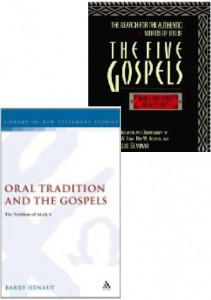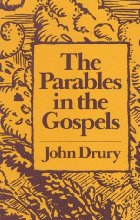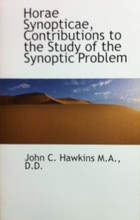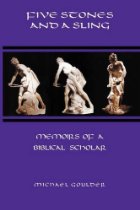 The parables of Jesus are among many people’s favourite treasures in the Bible and the focus of much erudite and popular research outputs by some of the most renowned scholars in the field. In The Five Gospels Robert Funk, Roy Hoover and the Jesus Seminar confidently point to the triadic structure (groups of threes) as well as the repetitions and catchwords — all characteristics of oral sayings — in the Parable of the Sower (Mark 4) to assert that this parable most likely originated as the very words of Jesus himself. The same year (1993) saw Barry Henaut’s publication, Oral Tradition and the Gospels: The Problem of Mark 4, that comprehensively demolished the claim that triadic structures, repetitions and mnemonic catchwords are unique to oral communications and demonstrated that the same features were also characteristic of ancient literary compositions that were written to be read aloud to audiences.
The parables of Jesus are among many people’s favourite treasures in the Bible and the focus of much erudite and popular research outputs by some of the most renowned scholars in the field. In The Five Gospels Robert Funk, Roy Hoover and the Jesus Seminar confidently point to the triadic structure (groups of threes) as well as the repetitions and catchwords — all characteristics of oral sayings — in the Parable of the Sower (Mark 4) to assert that this parable most likely originated as the very words of Jesus himself. The same year (1993) saw Barry Henaut’s publication, Oral Tradition and the Gospels: The Problem of Mark 4, that comprehensively demolished the claim that triadic structures, repetitions and mnemonic catchwords are unique to oral communications and demonstrated that the same features were also characteristic of ancient literary compositions that were written to be read aloud to audiences.
.
This post follows on from What Is a Parable? My original intent was to post the outline of Michael Goulder’s reasons for concluding that the parables we know so well from the gospels were the literary creations of the evangelist authors of those gospels and did not derive from anything Jesus said.
 Before I had a chance to continue with that plan one most helpful reader alerted me to John Drury’s book The Parables in the Gospels: History and Allegory.
Before I had a chance to continue with that plan one most helpful reader alerted me to John Drury’s book The Parables in the Gospels: History and Allegory.
I’ll keep this post’s main focus on the Gospel of Mark, widely thought to be the earliest gospel written. Matthew, Luke and (a significant number of scholars believe) John knew and adapted Mark’s material to serve their own theological and literary purposes.
I know we remember all this but. . .
From the earlier What Is a Parable? post we saw that the Greek word in the Bible that we translate as “parable” was derived from the Greek version of the Old Testament (the Septuagint/LXX) and embraced what in Hebrew was a word (mashal) that embraced a wide range of figurative expressions. It could be a pithy proverbial saying, an extended allegorical tale, a prophetic oracle, a riddle, a song of derision or a byword. It was generally a saying with a hidden meaning that needed to be deciphered. It generally professed to explain God’s will behind some historical condition. It was always an integral part of its surrounding narrative.
That last mentioned trait alone is a significant reason for believing such parables were the creations of the authors of the works in which they appeared. Authors wrote with a plan, a structure in mind, and his or her creativity fleshed that scheme out with imaginative details. In creative works each word, each image, is set down as part of the larger creative process. Each word and image serves a purpose that propels the flow of the narrative towards its logical and necessary theme and outcome.
When an author is constrained in his choice of content by a need to be true to “what was really historically said” then the narrative will tend to be episodic and not as neatly woven into a literary whole. We would expect a stop-start character to the narrative
I don’t mean to compare Mark with Homer but. . .
Here one might think of the Gospel of Mark as indeed crudely and disjointedly episodic but one would be mistaken. Homer’s and Virgil’s epics were also largely episodic, as were probably most forms of ancient creative literature, but their episodes are artfully woven together with literary devices and the larger thematic structure of the whole. Not that the Gospel of Mark can be compared to the classical epics for literary merit but it certainly does mirror the well-known structures of a climactic resolution (the Passion and Resurrection narrative) being preceded by mounting tensions building up incrementally through thematically tied anecdote after anecdote.
Not just a few pretty stories

Back to the parables. Let’s continue with the Parable of the Sower. About 25 years ago a fascinating book appeared: Sowing the Gospel, by Mary Ann Tolbert. It demonstrated (quite successfully in most respects, I believe) that the Parable of the Sower set out in miniature the larger part of the narrative theme and destinies of the various characters in the Gospel of Mark. That is, the Parable explained what a large section of the Gospel was about. The various persons in the gospel who encountered Jesus could all be seen as either barren soil, or weed infested soil, or rock-cluttered soil — they all reacted to the seed (or word of Jesus) that fell their way by dismissing it out of hand, or letting riches and other worldly cares take over, or (as in the case of the “rock-led” disciples) lasting well until the heat of persecution came. It was up to the readers or hearers of this Gospel to ask who the good soil were.
As the Gospel moves towards the climax of the Passion narrative it presents readers with another allegorical narrative, the Parable of the Wicked Tenants. This story of the killing of the rightful heir to the kingdom sets the theme for the following scene of the killing of Jesus. The Parable explains to readers what the ensuing narrative is really all about — i.e., the slaying of the Son of the God who was about to avenge his Son’s death.
Let’s return to the opening chapters of this gospel where the beginnings of Jesus’s conflicts with the evils of this world and its structures begins. People are said to be astonished beyond measure at the way he could expel demons and “speak with authority” (even though we are not really told much about what he actually taught). Pharisees and other guardians of the law from Jerusalem were offended over his flagrant tearing apart of “the rules” such as avoiding the wrong company and rendering sabbath regulations irrelevant when it came to doing good that no-one else had done before. Even when Jesus commanded someone he healed to observe all the due regulations and sacrifices his efforts were wasted: the one healed could not help but dismiss such commands and do the very opposite for the thrill of his liberated healing.
And what do we find in the early chapters of this little series of narratives that set the scene of Jesus as the one who breaks all the old boundaries and begins to cast out all the evil powers? Parables, sayings, riddles, that explain to the reader exactly what these scenes are all about. That’s why we read about new wine not being poured into old wineskins and about marriage feasts when no-one can fast. The mini-parables explain once again what the opening chapters of the Gospel are about.
The parables appear to have been manufactured to serve the interests of the entire gospel narrative.
When we read of these sorts of sayings or parables being so well integrated into the larger narrative itself it really does look as though a creative author has made them up out of his own imagination as just the right images to reinforce the story at each of its significant literary-thematic and theological turning points. Such parables do not look like they have been inherited cold leaving the author to find some way to artificially weave them into a literary whole.
Don’t forget the history lessons
Recall the earlier post What Is a Parable? where we saw the way Drury found that OT parables were integral parts of larger narratives. He also said that they were set up to explain God’s plan for history. I have not covered that here but it really deserves as much space as the above. The Parable of the Sower explains not only the narrative’s characters but the real-life experiences of the early Christians of Mark’s day. The Parable of the Wicked Tenants, of course, is clearly an explanation of why God allowed or sent the Romans to destroy Jerusalem and also to give hope to those who were still being persecuted.
If that is all the evidence we had — literary integration — we might still be tempted to toy with the possibility that this Gospel’s author had superior literary talents for weaving diverse foreign material into his own imaginative narratives so seamlessly and fruitfully. Drury tells us there is more, however.
An exciting but preposterous possibility
 Enter the next witnesses: Sir John Hawkins, author of Horace Synopticae and the more severe E. J. Pryke, author of Redactional Style in the Marcan Gospel. These scholars have identified words that are characteristic of the Gospel of Mark (as distinct from word usages in the other Gospels). Their respective analyses point to the following words in the Parable of the Sower being distinctively Mark’s contributions:
Enter the next witnesses: Sir John Hawkins, author of Horace Synopticae and the more severe E. J. Pryke, author of Redactional Style in the Marcan Gospel. These scholars have identified words that are characteristic of the Gospel of Mark (as distinct from word usages in the other Gospels). Their respective analyses point to the following words in the Parable of the Sower being distinctively Mark’s contributions:
- verse 3
- Hear!
- Behold!
- verse 5
- Suddenly
- verse 6
- Dried out
- verse 7
- Rose up
- verse 8
- Bore
- verse 9
- Hear!
- To hear
That’s vocabulary. What about syntax? Again, the of a total of fourteen distinctively Marcan features five are found in the Parable of the Sower:
- Parenthetical explanatory clauses that tend to lead author astray —
- verse 5 “because it had no depth of earth”
- verse 6 “because it had no root”
- Participles replacing verbs —
- verse 8 “coming up and increasing”
This is also Mark’s characteristic ‘juxtaposition of similar or contrasting words’ in ‘a rhythmic thought process’.
- Frequent use of ‘suddenly’ (v. 5)
- Use of redundant participles as at v. 8 and v. 3. ‘The sower went out to sow’.
- Use of two more more participles together before or after the main verb as at v. 8 — the main verb ‘gave (fruit)’ followed by ‘coming up and increasing’.
Drury concludes:
Again a fair total [of distinctively Marcan features] . . . and a fair spread. On these grounds of vocabulary and syntax it seems that if we have here ‘a literal translation Greek version of a parable of Jesus’ then we have it in a literal translation Greek version of a book by Jesus — an exciting possibility if it were not preposterous. (p. 55)
Goulder gets a word in at last
 Now is an appropriate moment to return to my original target author for this topic, Michael Goulder. Here is Goulder’s distilled reflection on how he came to the conclusion that the parables of Jesus originated as literary creations by each Gospel author:
Now is an appropriate moment to return to my original target author for this topic, Michael Goulder. Here is Goulder’s distilled reflection on how he came to the conclusion that the parables of Jesus originated as literary creations by each Gospel author:
It was well known that all the best parables come in Luke’s Gospel, like the Good Samaritan and the Prodigal Son. The more I thought of it the more it seemed that each Synoptic Gospel had its own style of parable.
Mark’s parables were mostly agricultural: the Sower, the Seed Growing Secretly, the Mustard Seed. This was rather in line with Old Testament parables, which are said often to be about trees, ‘form the cedar in Lebanon to the hyssop that grows out of the wall’.
Matthew’s parables are about people, mostly kings or wealthy merchants. Luke’s parables, on the other hand, are about more down-to-earth characters: a prodigal son, an unjust steward, a widow, a beggar, a Samaritan. Feldman’s book put an interesting gloss on this: he gave numerous examples of rabbinic parables, many of which compare God to a king or wealthy landowner.
I therefore had a theme ready made for my Oxford seminar: the parable in the Gospels were not the parables of Jesus, as was assumed by almost everyone, including the authors of two of the best known books on the subject, C.H. Dodd in The Parables of the Kingdom, and J. Jeremias in Parables of Jesus: rather, they were the creation of the evangelists, each of whom produced instances in his own style. (Goulder: Five Stones and a Sling, pp. 58-59 — my bolding and formatting)
A double barrel shotgun
It is worth returning to two more significant points made by Drury before bringing this post to a close. The detailed argument can be found in Drury’s The Parables and the Gospels (possibly online at this link).
- The parables in Mark’s Gospel are told by Jesus in order to be confusing and remain hidden from the understanding of Jesus’ audience. Mark is following the script of Isaiah’s parables that are intended to be closed to the sense of the outsiders. The arguments to the contrary by Jeremias and others are demolished by Drury.
- The parables of Jesus in Mark are not everyday scenes from the lives of the ordinary folks with whom Jesus rubbed shoulders and related by means of these tales. The Parable of the Sower is as bizarre as any Old Testament parable. It makes no sense literally any more than do talking and walking trees in the OT. Sowers do not scatter seed on unploughed ground and across the byways and rocky soil etcetera, notwithstanding efforts of scholars to find some way of having Jesus talk sense by supposedly discovering such techniques among primitive farmers of the region.
These two points — each one also worth extensive elaboration — further point to the strong likelihood that these parables were not spoken historically to real audiences and certainly not by anyone who had the slightest intention of “relating” to peasantry through “common knowledge” of their daily experiences.
This post has pointed to arguments that establish the strong likelihood that at least the parables in the Gospel of Mark were the creative literary compositions of the evangelist himself.
If you enjoyed this post, please consider donating to Vridar. Thanks!

Neil,
Great post. You’ve brought together here some valuable insights on the parables.
I’m curious. Does Tolbert address how Mk. 6:14-29 (the death of John the Baptist) would fit into her explanation of GMark as a whole? And do Hawkins or Pryke examine Mk. 6:14-29 for characteristic Markan vocabulary?
Hawkins’ book, I have discovered, is available online at bookzz. (I’ve emailed you a copy of it.) It would be easier for you to consult — It would take you less time to cross check each word than it would for me to do it.
Tolbert says the usual things about the episode — its ominous portent for the fate and disciples of Jesus, the irony of John’s disciples taking his body and burying it against Jesus’ disciples fleeing leaving a stranger to do those things. Her special point is to say that it illustrates the failure of the word in the heart of one who is rich (Herod) “so soon after” the parable — and that the fact that it breaks the surrounding chiastic structure serves to emphasize this lesson. I confess I find that to be special pleading there — almost every other passage fits her chiastic structures; why break it to emphasize the lesson about the rich? And why single out the rich to be the illustration so close to the parable itself? Her treatment of the rich struck me as a weak spot in her thesis.
Is it worth mentioning the striking similarity with the last egerton fragment, where Jesus wasn’t speaking in parables but actually performing a miracle with seeds?
Good point. http://en.wikipedia.org/wiki/Egerton_Gospel
Yes, this variant is further evidence of what we see at work even among the canonical gospels: the authors are free to vary and re-write the texts of their predecessors in any way that serves to convey their own particular theological messages.